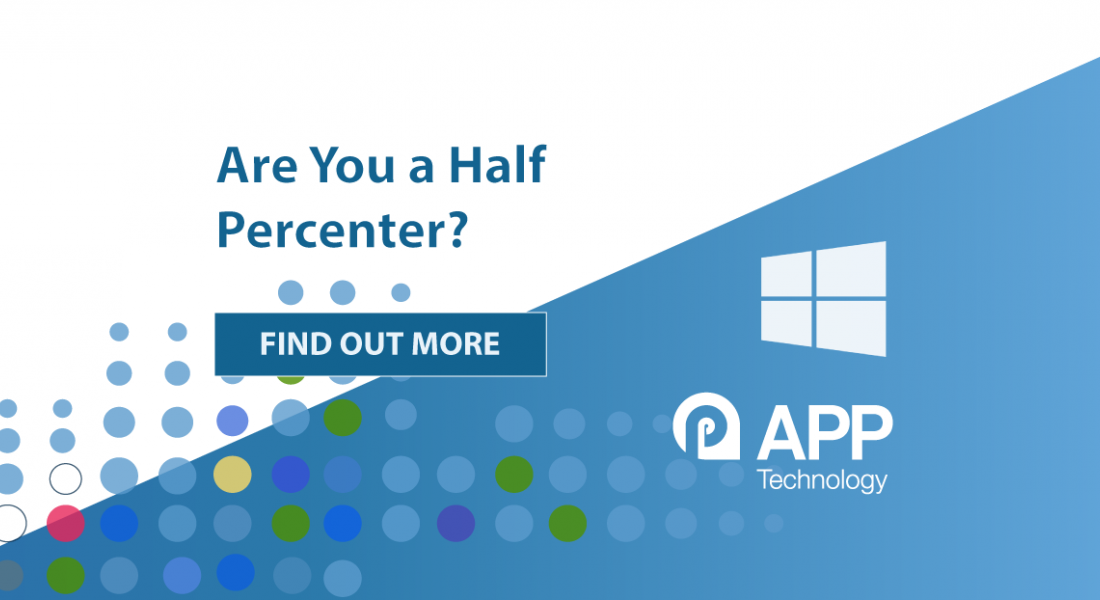Are you a Half Percenter?

Are you a Half Percenter?
How fast does Windows 10 servicing have to run in a large Enterprise?
This article walks through the cadence and logic of supporting Windows 10 in an Enterprise environment. The result, may surprise you and as you'll read, in a Windows 10 Large Enterprise environment you will need to be a half percenter.
The Benefits of Early Adoption?
Large Enterprises have been making it to the Windows 10 finishing line for a few years now and have been able to benefit from the enhanced security and functionality following their last ever “Big Bang” migrations from Window 7.
We have however seen that Enterprises who adopted Windows 10 early are now starting to view their next build transition as project work again, as opposed to embracing the Evergreen and Modern Workplace principles of Windows as a Service.
Those that migrated their entire environments to build 1709, have until April of next year (2020) to refresh their estate. Those who targeted the popular 1803 Windows 10 Enterprise build, have until November 2020 to retire this build before their platform becomes “End of Service”.
The Windows 10 release and support statements can be found at https://docs.microsoft.com/en-us/windows/release-information/.
Windows 10 Release support changes
The move to each year's September releases of Windows 10 carrying a 30-month support lifecycle for Enterprise versions means that most large organisations will ultimately adopt the XX09 release cycle, rather than chase the March releases and their 18 months support.
The realistic adoption of the XX09 release cycle has some interesting implications for the pace of change an Enterprise needs to deliver from a BAU / Windows as a Service basis…
Windows 10 Servicing logic – What does this look like?
For a September release of Windows 10, from build 1909 now referred to as Semi-Annual (Targeted), there will be a period of six months before the build is deemed “Business-Ready”. On older builds, this was an announcement from Microsoft, from build 1903 onwards this is a countdown of days set by a Windows setting before the build becomes simply the Semi-Annual Channel release. The six months of initial release does bite into the 30-month support cycle for each build.
From a September build becoming business-ready in March the following year, an Enterprise should undertake a broad phase of build testing. This shouldn’t be restricted to IT testing, we recommend testing a build in all aspects of a business, from Shipping to Executives, Finance to Reception. Given a responsive user base, you can probably cover a suitable level of live test analysis over a two-month period.
Buy yourself a one-month planning phase to schedule all upgrade activity, and then you’ll find you are starting your rollout in July of the year following release. This gives you a 9-month window for Windows 10 upgrade activity before the next 09 release is business-ready and you are starting your broad testing on the next release.
The Magic Number
Big bang Enterprise migrations of the past typically lasted 18 months. The first 12 months, were taken up with applications and infrastructure readiness, user comms, training preparation and digging up the migration killing issues. The last 6 months being delivery focused.
For example, for a typical 10,000 seat Enterprise you would probably try to migrate 100+ machines per night. Some nights you would overachieve, others would fall short. And of course, this would need your project team of engineers, comms managers, floorwalkers and project management. As a percentage this was a run rate of just under 1% of the environment every night, using a project team for delivery.
Instead, you now face just under 200 days in which to upgrade your Windows 10 builds before you need to be starting on the next release. And of course, that’s in a perfect world, with no unexpected delays, application issues or upgrade blockers. This equates to a run rate, every day, of 0.5% of your environment!
So, for Enterprises to effectively service their Windows 10 estate they need to be a Half Percenter upgrading 0.5% of their Windows 10 estate every day.
So that’s 50 Windows 10 Build upgrades per day for a 10,000-seat environment, delivered every working day as a BAU workload, in addition, to support rebuilds and new provisions. Combine this with the workload of user communications, broad testing management, build updates, language packs per build, and you start to see the Operational impact of Windows as a Service.
Oh, and the 0.5% per day doesn’t allow for the upgrade failures that chew up engineer time due to the real-world issues of broken or dark clients, devices with no disk space…. The list goes on.
If you are struggling, APPtechnology has an impressive range of services and automation solutions to help you deliver Evergreen management, Windows as a Service and the Microsoft Modern Workplace with the minimum of user impact, at the lowest possible resource requirements.
If you would like to see how we can assist your teams with workload support, automate the entire test, comms and release cycles, or deliver you a managed Evergreen Solution then please complete our “contact us” form, we don’t pester, and we are here to help.